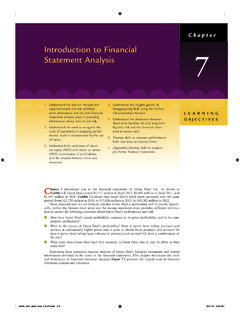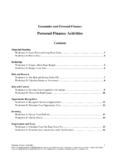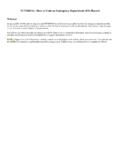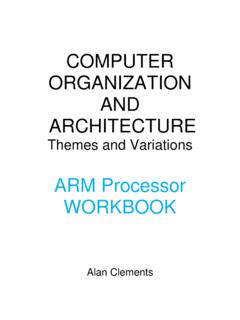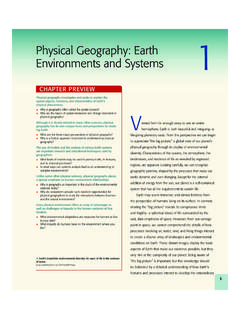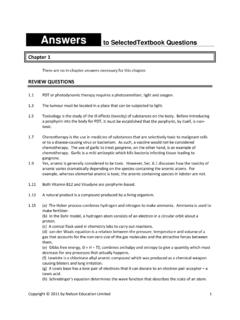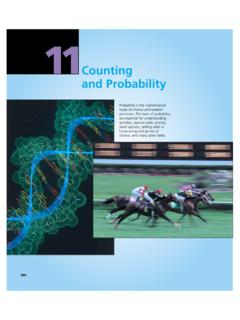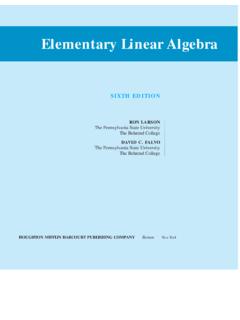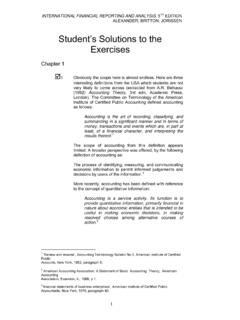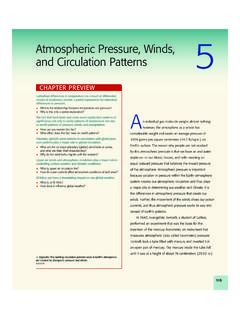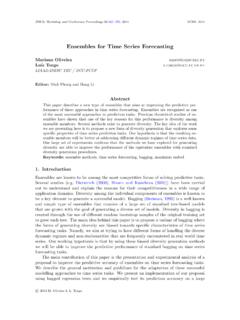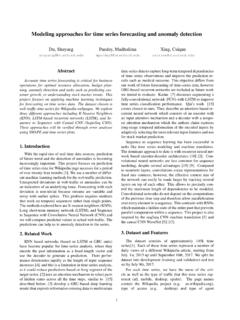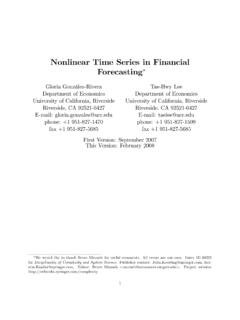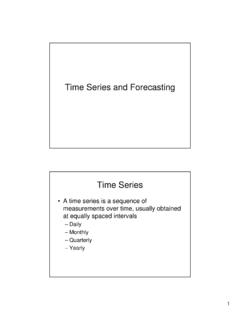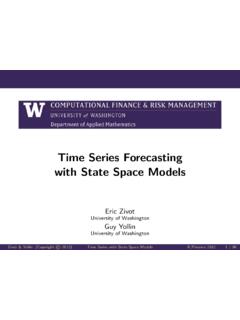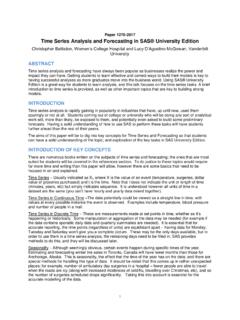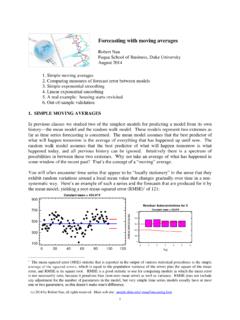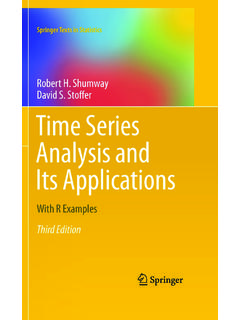Transcription of Time Series Analysis and Forecasting - Cengage
1 time Series Analysis and ForecastingCONTENTSSTATISTICS IN PRACTICE:NEVADA OCCUPATIONAL HEALTH Series PATTERNSH orizontal PatternTrend PatternSeasonal PatternTrend and Seasonal PatternCyclical PatternUsing Excel s Chart Tools to Construct a time Series PlotSelecting a Forecasting AVERAGES AND EXPONENTIALSMOOTHINGM oving AveragesUsing Excel s Moving Average ToolWeighted Moving AveragesExponential SmoothingUsing Excel s ExponentialSmoothing PROJECTIONL inear Trend RegressionUsing Excel s Regression Toolto Compute a LinearTrend EquationNonlinear Trend RegressionUsing Excel s Regression Toolto Compute a QuadraticTrend EquationUsing Excel s Chart Tools forTrend AND TRENDS easonality Without TrendSeasonality and TrendModels Based on Monthly SERIESDECOMPOSITIONC alculating the Seasonal IndexesDeseasonalizing the time SeriesUsing the Deseasonalized TimeSeries to Identify TrendSeasonal AdjustmentsModels Based on Monthly DataCyclical ComponentCHAPTER15 2012 Cengage Learning. All Rights Reserved.
2 May not be scanned, copied or duplicated, or posted to a publicly accessible website, in whole or in 15 time Series Analysis and ForecastingNevada Occupational Health Clinic is a privately ownedmedical clinic in Sparks, Nevada. The clinic specializesin industrial medicine. Operating at the same site formore than 20 years, the clinic had been in a rapid growthphase. Monthly billings increased from $57,000 to morethan $300,000 in 26 months, when the main clinic build-ing burned to the clinic s insurance policy covered physical prop-erty and equipment as well as loss of income due to theinterruption of regular business operations. Settling theproperty insurance claim was a relatively straightforwardmatter of determining the value of the physical propertyand equipment lost during the fire. However, determiningthe value of the income lost during the seven months thatit took to rebuild the clinic was a complicated matterinvolving negotiations between the business owners and theinsurance company.
3 No preestablished rules could helpcalculate what would have happened to the clinic sbillings if the fire had not occurred. To estimate the lost in-come, the clinic used a Forecasting method to project thegrowth in business that would have been realized duringthe seven-month lost-business period. The actual history ofbillings prior to the fire provided the basis for a forecastingmodel with linear trend and seasonal components asdiscussed in this chapter. This Forecasting model enabledthe clinic to establish an accurate estimate of the loss,which was eventually accepted by the insurance OCCUPATIONAL HEALTH CLINIC*SPARKS, NEVADASTATISTICSinPRACTICE*The authors are indebted to Bard Betz, Director of Operations, andCurtis Brauer, Executive Administrative Assistant, Nevada OccupationalHealth Clinic, for providing this Statistics in purpose of this chapter is to provide an introduction to time Series Analysis and fore-casting. Suppose we are asked to provide quarterly forecasts of sales for one of our com-pany s products over the coming one-year period.
4 Production schedules, raw materialpurchasing, inventory policies, and sales quotas will all be affected by the quarterly fore-casts we provide. Consequently, poor forecasts may result in poor planning and increasedcosts for the company. How should we go about providing the quarterly sales forecasts?Good judgment, intuition, and an awareness of the state of the economy may give us a roughidea or feeling of what is likely to happen in the future, but converting that feeling into anumber that can be used as next year s sales forecast is methods can be classified as qualitative or quantitative. Qualitative meth-ods generally involve the use of expert judgment to develop forecasts. Such methods areappropriate when historical data on the variable being forecast are either not applicable orunavailable. Quantitative Forecasting methods can be used when (1) past information aboutthe variable being forecast is available, (2) the information can be quantified, and (3) it isreasonable to assume that the pattern of the past will continue into the future.
5 In such cases,A physician checks a patient s blood pressure at the Nevada Occupational Health Clinic. Bob Pardue Medical forecast is simply aprediction of what willhappen in the must learn toaccept that regardless ofthe technique used, theywill not be able to developperfect forecasts. 2012 Cengage Learning. All Rights Reserved. May not be scanned, copied or duplicated, or posted to a publicly accessible website, in whole or in time Series Patterns15-3a forecast can be developed using a time Series method or a causal method. We will focusexclusively on quantitative Forecasting methods in this the historical data are restricted to past values of the variable to be forecast, the fore-casting procedure is called a time Series methodand the historical data are referred to as atime Series . The objective of time Series Analysis is to discover a pattern in the historicaldata or time Series and then extrapolate the pattern into the future; the forecast is basedsolely on past values of the variable and/or on past forecast errors.
6 Causal Forecasting methods are based on the assumption that the variable we are fore-casting has a cause-effect relationship with one or more other variables. In the discussionof regression Analysis in Chapters 12 and 13, we showed how one or more independent vari-ables could be used to predict the value of a single dependent variable. Looking atregression Analysis as a Forecasting tool, we can view the time Series value that we want toforecast as the dependent variable. Hence, if we can identify a good set of related indepen-dent, or explanatory, variables, we may be able to develop an estimated regression equationfor predicting or Forecasting the time Series . For instance, the sales for many products areinfluenced by advertising expenditures, so regression Analysis may be used to develop anequation showing how sales and advertising expenditures are related. Once the advertisingbudget for the next period is determined, we could substitute this value into the equation todevelop a prediction or forecast of the sales volume for that period.
7 Note that if a time se-ries method were used to develop the forecast, advertising expenditures would not be con-sidered; that is, a time Series method would base the forecast solely on past sales. By treating time as the independent variable and the time Series variable as a dependentvariable, regression Analysis can also be used as a time Series method. To help differentiatethe application of regression Analysis in these two cases, we use the terms cross-sectional regressionandtime Series regression. Thus, time Series regression refers to the use of regression Analysis when the independent variable is time . Because our focus in this chapteris on time Series methods, we leave the discussion of the application of regression analysisas a causal Forecasting method to more advanced texts on Forecasting . time Series PatternsAtime seriesis a sequence of observations on a variable measured at successive points intime or over successive periods of time . The measurements may be taken every hour, day,week, month, or year, or at any other regular pattern of the data is an impor-tant factor in understanding how the time Series has behaved in the past.
8 If such behavior canbe expected to continue in the future, we can use the past pattern to guide us in selecting anappropriate Forecasting identify the underlying pattern in the data, a useful first step is to construct a timeseries plot. A time Series plot is a graphical presentation of the relationship between timeand the time Series variable; time is on the horizontal axis and the time Series values areshown on the vertical axis. Let us review some of the common types of data patterns thatcan be identified when examining a time Series PatternAhorizontal patternexists when the data fluctuate around a constant mean. To illustrate atime Series with a horizontal pattern, consider the 12 weeks of data in Table These limit our discussion to time Series in which the values of the Series are recorded at equal intervals. Cases in which theobservations are made at unequal intervals are beyond the scope of this SALESTIME SERIESS ales (1000sWeekof gallons)11722131942351861672081892210201 1151222 2012 Cengage Learning.
9 All Rights Reserved. May not be scanned, copied or duplicated, or posted to a publicly accessible website, in whole or in the number of gallons of gasoline sold by a gasoline distributor in Bennington, Vermont,over the past 12 weeks. The average value or mean for this time Series is or 19,250 gallons per week. Figure shows a time Series plot for these data. Note how the data fluctuate around the sample mean of 19,250 gallons. Although random variability is present,we would say that these data follow a horizontal pattern. The term stationary time series2is used to denote a time Series whose statistical prop-erties are independent of time . In particular this means that1. The process generating the data has a constant The variability of the time Series is constant over time Series plot for a stationary time Series will always exhibit a horizontal pattern. Butsimply observing a horizontal pattern is not sufficient evidence to conclude that the timeseries is stationary.
10 More advanced texts on Forecasting discuss procedures for determiningif a time Series is stationary and provide methods for transforming a time Series that is notstationary into a stationary in business conditions can often result in a time Series that has a horizontalpattern shifting to a new level. For instance, suppose the gasoline distributor signs a con-tract with the Vermont State Police to provide gasoline for state police cars located insouthern Vermont. With this new contract, the distributor expects to see a major increasein weekly sales starting in week 13. Table shows the number of gallons of gasoline soldfor the original time Series and for the 10 weeks after signing the new contract. Figure shows the corresponding time Series plot. Note the increased level of the timeseries beginning in week 13. This change in the level of the time Series makes it more dif-ficult to choose an appropriate Forecasting method. Selecting a Forecasting method thatadapts well to changes in the level of a time Series is an important consideration in manypractical applications.
